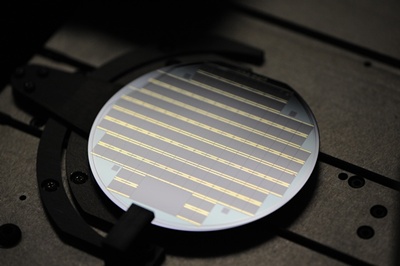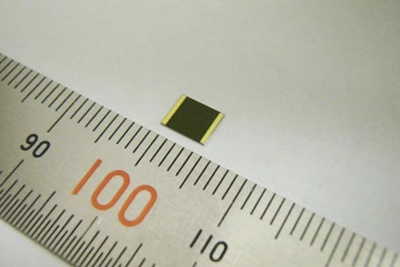First production order comes from Solar Junction–in which the UK-headquartered wafer foundry has a$5M equity stake.
 Semiconductor wafer featuring multi-junction cells
Semiconductor wafer featuring multi-junction cells
The advanced semiconductor epiwafer foundry IQE is to begin volume manufacture of multi-junction cells for concentrated photovoltaics(CPV)applications for strategic partner Solar Junction.
In a deal worth close to$2 million,IQE will provide both production wafers for CPV installations and development wafers intended to help Solar Junction–already established as having made the world's most efficient solar cell with a 43.5%device–push efficiencies towards 50%.
The agreement is the latest in a sequence of events in which CPV appears to be establishing itself as a viable and cost-effective approach to generating solar electricity in locations with high levels of sunshine such as southern California.
In February,IQE invested$5 million as part of Solar Junction's series D round of venture funding,in return for an exclusive epiwafer supply deal.The San Jose firm had previously intended to construct its own cell manufacturing capability with the support of a US Department of Energy(DOE)loan guarantee.
But,following the negative impact of the Solyndra affair on DOE loan guarantees last year,Solar Junction has decided to follow an outsourced manufacturing model for the critical epiwafer production stage,in which the complex semiconductor layers that form the active parts of the solar cell are deposited.
Since then,CPV system company SolFocus has set up a 5 MW cell supply deal with Solar Junction,following an agreement to provide thousands of its systems for a planned 450 MW project in Baja California,Mexico–the largest CPV installation announced to date.
Production scale available
Meanwhile,IQE has struck a deal to acquire high-volume molecular beam epitaxy(MBE)capacity from the phone handset component maker RF Micro Devices(RFMD).Until now,that equipment has been used to produce gallium arsenide-based RF chips,but the same manufacturing kit can also be used to produce the CPV wafers.
At the time of the RFMD deal,IQE president Drew Nelson explained:"The spare capacity currently existing within the transferred[RFMD]facilities will be applied to the manufacture of CPV solar wafers,enabling IQE to rapidly build a global leadership position in the supply of wafers for the burgeoning CPV sector as a result of our previously announced agreement and exclusive supply contract with CPV technology partner Solar Junction."
Commenting on the latest agreement with Solar Junction,Nelson added:"This order from Solar Junction is a clear indication that CPV technology is gaining significant traction in large-scale power generation in sunny areas."
And that positive sentiment was echoed by the cleantech industry analyst Lux Research last week.As yet,there is still very little in the way of CPV installations and generating capacity on the ground.But Ed Cahill from Lux says that CPV is on the way to becoming cost-competitive with conventional silicon-based PV,and that the market for CPV systems will be worth some$1.6 billion in 2017,with the market for CPV modules worth$700 million.
The approach should also benefit from one of the key macro trends in the solar industry,as funding is shifted away from heavily subsidized residential installations in Europe and towards large,utility-scale projects in sunnier locations such as India and the south-western US.
Cahill says that the CPV approach is"poised to finally hit its stride",and that the market will grow at a compound rate of 31%to account for around 700 MW worth of annual solar power installations by 2017.
Growing competition
That sounds like good news for the likes of IQE and Solar Junction,although there are lots of cell developers vying to enter the sector and challenge the current market leaders Spectrolab(part of Boeing)and Emcore,which is presently scaling up cell capacity through investments in China.
Cahill has also warned against over-aggressive plays by those in the emerging industry.His CPV report observes that the US-based system company Amonix–previously touted by Lux as a likely candidate for a successful initial public offering(IPO)–has expanded too fast and had to cut back.
"It struggles,and leaves the door open for emerging players like Soitec,[Emcore joint venture]SunCore and SolFocus,"Cahill noted.
The supply of high-performance CPV cells could also be influenced by the re-emergence on the scene of the Japanese giant Sharp.In late May,the company said that its new triple-junction design had matched the world-record 43.5%efficiency level set a year earlier by Solar Junction.
 Sharp's record-equaling 43.5%triple-junction cell
Sharp's record-equaling 43.5%triple-junction cell
The Sharp approach is slightly different to that of Solar Junction,with the latter using so-called"dilute nitride"semiconductor layers to help absorb more of the solar spectrum.Sharp's InGaAs/GaAs/InGaP structure was developed through funding from Japan's New Energy and Industrial Technology Development Organization(NEDO),and represented a huge improvement on the company's previous best of 36.9%.
Although it missed out on a DOE-guaranteed loan,Solar Junction did recently win$5 million from the same government department under the"Sunpath"program to further improve conversion efficiencies and make CPV directly competitive with conventional energy sources.
Lux's Cahill anticipates a"steady roadmap"to 45%cell efficiency within five years,and to 50%within a decade.If those targets can be met,CPV will be well on course to provide cheap solar electricity in parts of the world boasting the highest levels of sunshine.





